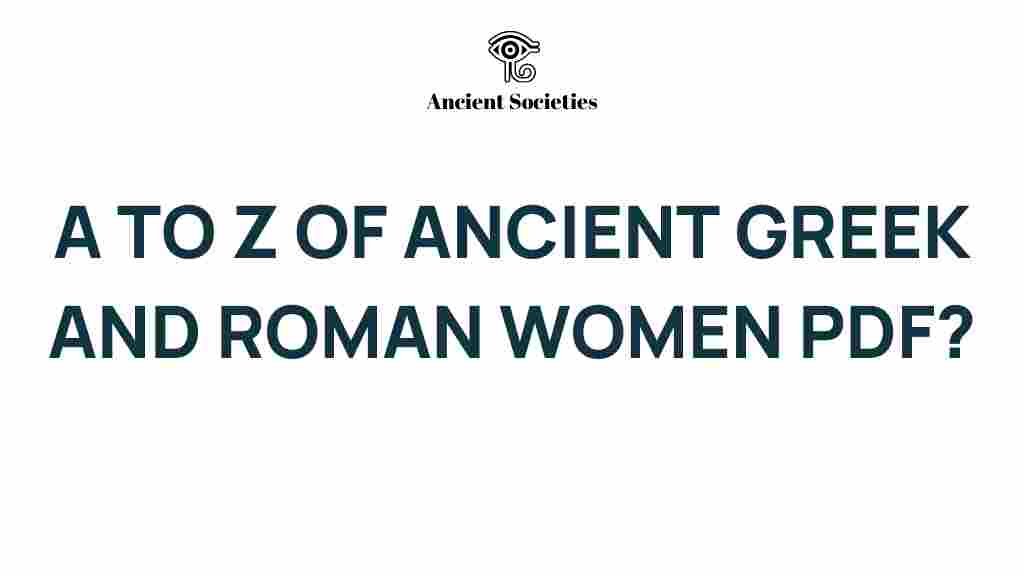Unveiling the Lives of Ancient Greek and Roman Women: A Hidden Legacy
The exploration of ancient civilizations often focuses on the prominent figures and grand structures that symbolize their greatness. However, the lives of women in Ancient Greece and the Roman Empire reveal a complex tapestry of experiences that speak volumes about their roles within society. This article aims to uncover the hidden legacy of these women, examining their societal norms, cultural contributions, and the empowerment they found despite the constraints of their time.
The Historical Context of Ancient Greece and Roman Women
To understand the lives of women in ancient civilizations, we must first explore the historical backdrop. In both Ancient Greece and Rome, societal norms dictated distinct gender roles that often relegated women to the private sphere. However, their influence and contributions were significant, albeit often overlooked.
- Gender Roles: Women were primarily seen as wives and mothers, responsible for managing households and raising children.
- Public Life: While men dominated public life, some women found ways to exert influence through religious practices, festivals, and even political intrigue.
- Legal Status: Women in both cultures had limited rights, but variations existed; for instance, Roman women could own property, while Greek women could not.
Archaeological Evidence of Women’s Lives
Archaeology has played a pivotal role in reconstructing the lives of women in ancient societies. Artifacts, inscriptions, and architectural findings provide insight into the daily lives and societal roles of these women.
- Pottery and Household Items: These artifacts illustrate domestic life, showcasing the skills of women in pottery and textiles.
- Grave Goods: The items buried with women reflect their status, beliefs, and roles within their families and communities.
- Literary Sources: Works by authors such as Homer and Plutarch, while primarily focused on men, also offer glimpses into the lives of women.
Cultural Contributions of Women
Despite societal limitations, women in Ancient Greece and Rome made notable contributions to culture, art, and religion. Their involvement in these areas often went unnoticed, but their impact was profound.
- Religious Roles: Women often served as priestesses, holding significant spiritual authority within their communities.
- Literature and Philosophy: Some women, such as Sappho, gained recognition for their poetic contributions, while others participated in philosophical discourse.
- Art and Craftsmanship: Women were involved in creating art, textiles, and other crafts that were integral to their cultures.
Empowerment Through Resistance
While women in ancient societies faced numerous constraints, many found ways to assert their agency and challenge societal norms. This empowerment is evident in various ways:
- Education: Some women, particularly in Rome, received education and engaged in intellectual pursuits, defying the expectation of ignorance.
- Political Influence: Women like Livia Drusilla, the wife of Emperor Augustus, played crucial roles behind the scenes, influencing political decisions.
- Literary Expression: Writing provided a platform for women to express their thoughts and experiences, contributing to a legacy that would inspire future generations.
The Evolution of Gender Roles
Understanding the evolution of gender roles in ancient societies is essential to grasp the complexities of women’s lives. While many norms were rigid, changes occurred over time that began to challenge traditional views.
- Late Antiquity: By this period, women began to gain more recognition in public life, participating in religious and social activities.
- Influence of Christianity: With the rise of Christianity, women’s roles in religious contexts expanded, offering new avenues for empowerment.
- Legal Reforms: Over time, legal changes in Rome began to grant women more rights, particularly concerning property ownership.
Troubleshooting Misconceptions
Despite the wealth of archaeological evidence, misconceptions about the status of women in ancient civilizations persist. Here are some common myths and clarifications:
- Myth: Women in Ancient Greece had no freedom.
- Fact: While their freedoms were limited, some women exercised considerable influence within their households and communities.
- Myth: All Roman women were confined to the home.
- Fact: Many Roman women participated in business, owned properties, and engaged in social and political life.
To further understand this topic, explore the history of women in ancient civilizations.
Conclusion: The Legacy of Ancient Greek and Roman Women
The lives of women in Ancient Greece and Rome reveal a hidden legacy that challenges the prevailing narratives of history. While societal norms and gender roles often constrained them, many women found ways to assert their influence, contribute to culture, and empower themselves within their communities. The archaeological evidence, coupled with literary insights, allows us to appreciate the rich and complex lives of these women, who played vital roles in shaping the ancient world.
As we continue to explore and uncover the past, it is essential to recognize the significant contributions of women in ancient civilizations, understanding that their stories are integral to the broader narrative of history. Their legacy of resilience and empowerment serves as a reminder that even in the most challenging circumstances, the human spirit can prevail.
This article is in the category History and created by AncientSocieties Team
